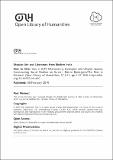Files in this item
Interweaving dystopian and utopian spaces, constructing social realism on screen : Bakita Byaktigato/The Rest is Personal
Item metadata
| dc.contributor.author | Sen, Sanghita | |
| dc.date.accessioned | 2019-03-22T11:30:08Z | |
| dc.date.available | 2019-03-22T11:30:08Z | |
| dc.date.issued | 2019-02-08 | |
| dc.identifier | 258270205 | |
| dc.identifier | 572022f4-6102-4b50-8692-a0b8a2a96a29 | |
| dc.identifier | 85065135789 | |
| dc.identifier | 000464652600014 | |
| dc.identifier.citation | Sen , S 2019 , ' Interweaving dystopian and utopian spaces, constructing social realism on screen : Bakita Byaktigato/ The Rest is Personal ' , Open Library of Humanities , vol. 5 , no. 1 , 14 , pp. 1-27 . https://doi.org/10.16995/olh.410 | en |
| dc.identifier.issn | 2056-6700 | |
| dc.identifier.other | crossref: 10.16995/olh.410 | |
| dc.identifier.uri | https://hdl.handle.net/10023/17344 | |
| dc.description.abstract | This article investigates the role of utopian and dystopian spaces in the construction of social realism in Bakita Byaktigato/The Rest is Personal (Pradipta Bhattacharya, 2013). The inherent contradiction between the implausible fictional construct of utopian and dystopian spaces and the existing socio-political reality is finely foregrounded through multiple loci of narrative actions. The film, based in Kolkata, revolves around Pramit, an aspiring documentary film-maker, and his quest for love. There are two spaces in the depiction of Kolkata: the city that contains the contemporary socio-political reality which is neither utopic or dystopic, and its dystopic underbelly that embodies the absence of hope for redemption or respite for its inhabitants. Pramit meets a fraudulent astrologer who occupies the dystopian space of ‘darkened shadows’ but knows about the utopian space that remains beyond his reach. The dystopian space is riddled with poverty, deprivation, unfulfilled desire, and hopelessness, along with fear and volatility. The final locus is a village called Mohini, a utopian space representing absolute harmony and undiluted bliss. Only the chosen ones have the privilege to enter the village. Everyone is happy in this space and prone to falling in love that lasts a lifetime. This is commemorative of arshinagar (‘the mirror city’), a coveted space in bāul practices and a metaphor for a utopian space that stands in stark contrast with the reality. By interweaving these spaces in his cinematic experimentation, Bhattacharya addresses issues such as folk-cultural practices and community, economic crises and class, caste hierarchy, and social relationships, while attempting to create an alternative cinematic language to counter the filmmaking practices in Bengal that rendered itself vestigial. | |
| dc.format.extent | 477903 | |
| dc.language.iso | eng | |
| dc.relation.ispartof | Open Library of Humanities | en |
| dc.subject | PN1993 Motion Pictures | en |
| dc.subject | T-NDAS | en |
| dc.subject.lcc | PN1993 | en |
| dc.title | Interweaving dystopian and utopian spaces, constructing social realism on screen : Bakita Byaktigato/The Rest is Personal | en |
| dc.type | Journal article | en |
| dc.contributor.institution | University of St Andrews. Film Studies | en |
| dc.identifier.doi | https://doi.org/10.16995/olh.410 | |
| dc.description.status | Peer reviewed | en |
This item appears in the following Collection(s)
Items in the St Andrews Research Repository are protected by copyright, with all rights reserved, unless otherwise indicated.

